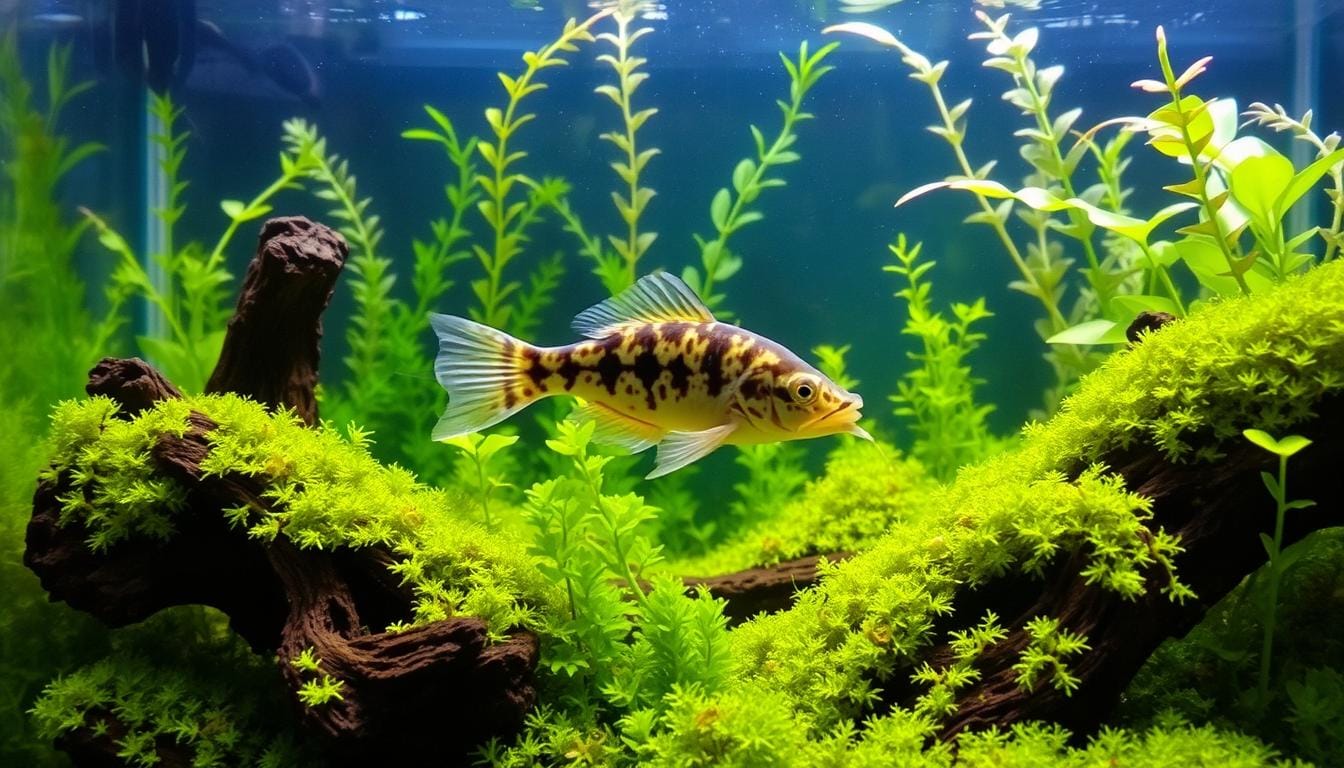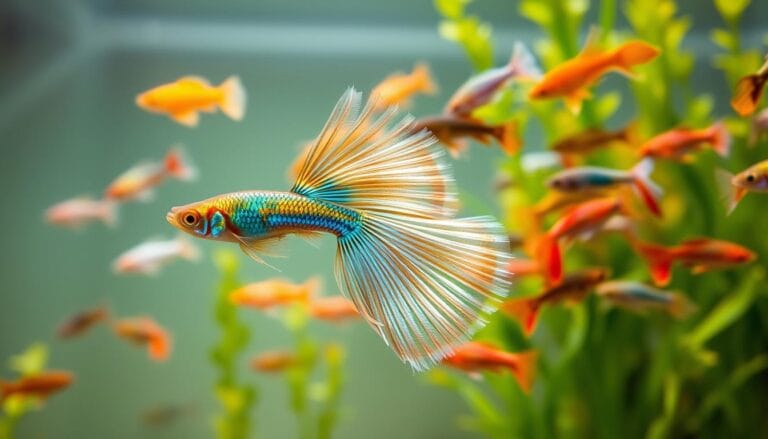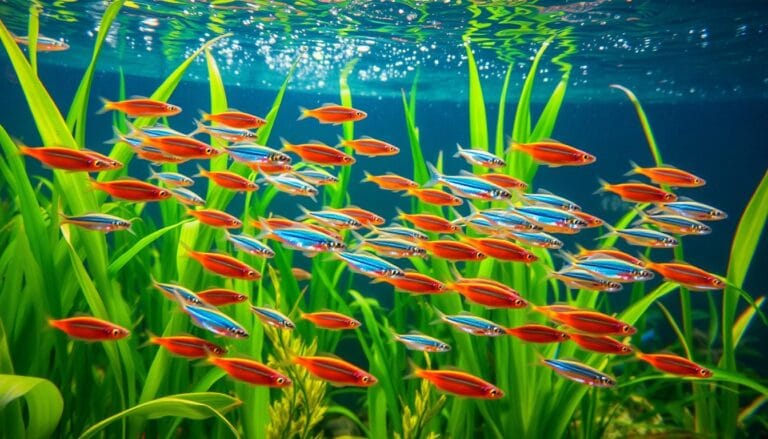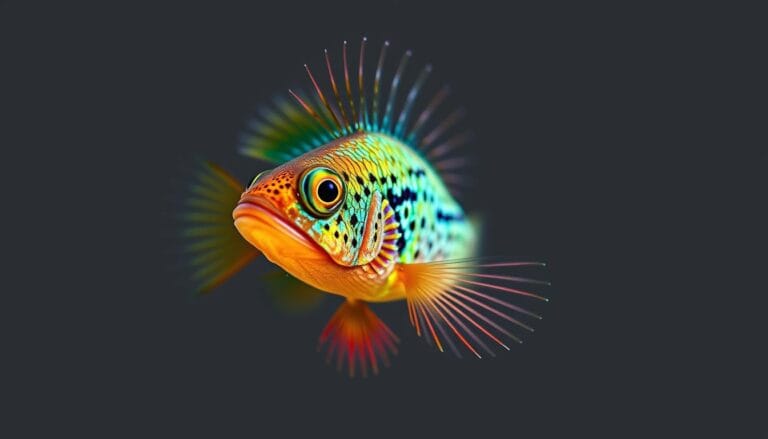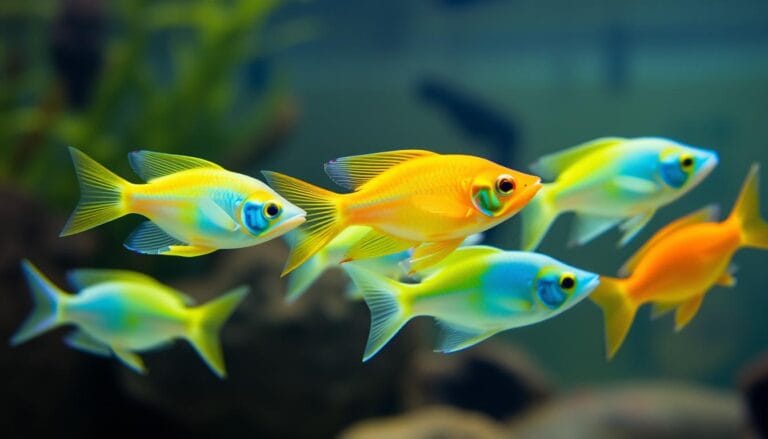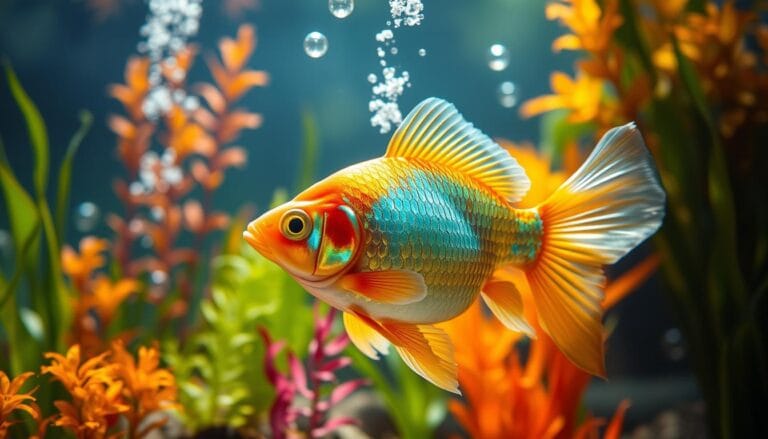Otocinclus Catfish: 5 Care Tips for Healthy Algae Eaters
Welcome to our guide on otocinclus catfish. Here, you’ll learn how to keep your fish healthy and thriving. Otocinclus catfish are great for community aquariums because they help control algae. We’ll share 5 essential care tips, from their natural habitat to setting up the perfect tank.
Table of Contents
Key Takeaways
- Understand the natural habitat and behavior of otocinclus catfish to provide the best otocinclus care
- Set up a perfect tank environment with suitable water parameters for your otocinclus catfish
- Learn about the ideal diet and feeding guidelines for your otocinclus catfish
- Choose the right tank mates for a harmonious community aquarium
- Be aware of common health issues and take preventive measures for your otocinclus catfish
Understanding Your Otocinclus Catfish
To care for your otocinclus catfish well, knowing their natural home and behavior is key. These fish, known as ottos, come from South America. They live in slow streams and rivers. They are small, calm fish that do best in groups.
They have a unique spot and stripe pattern. Otocinclus catfish are usually 1-2 inches long. This makes them perfect for smaller tanks. With the right care, they can live up to 5 years.
Natural Habitat and Behavior
In the wild, otocinclus catfish live in big groups. They eat algae and small bugs. They are friendly fish and don’t fight with others, so they’re great for community tanks.
Physical Characteristics
Otocinclus catfish are small, calm, and have a special spot and stripe pattern. They can stick to plants and rocks. They use their suckermouth to eat algae.
Lifespan and Growth
Otocinclus catfish can live up to 5 years in a tank. They grow to 1-2 inches long. With good care and food, they can do well in a clean aquarium.
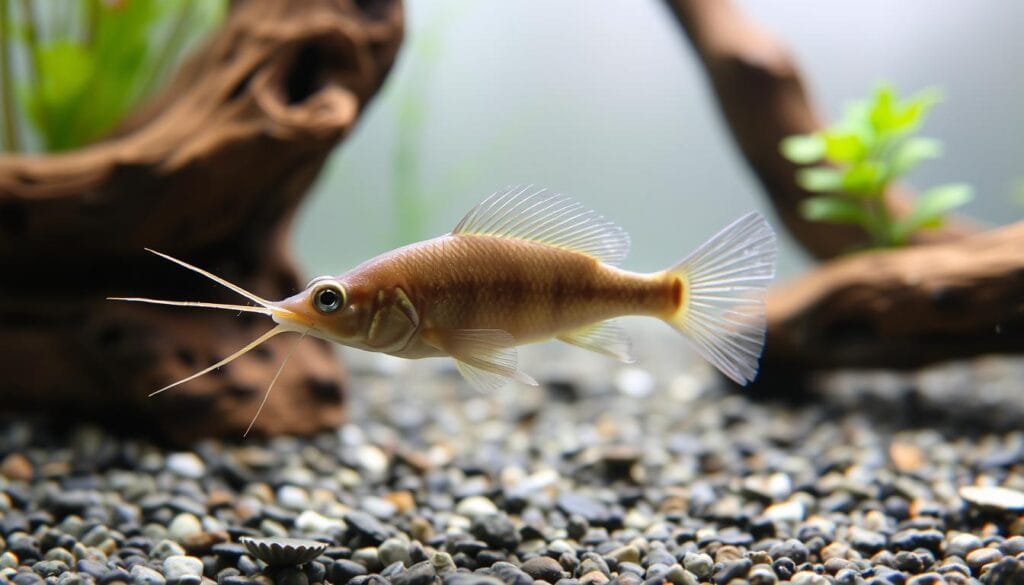
Knowing about your otocinclus catfish’s natural home and behavior helps you care for them. This way, you can make a happy aquarium for them.
| Characteristics | Description |
|---|---|
| Size | 1-2 inches in length |
| Lifespan | Up to 5 years in captivity |
| Nature | Peaceful, gentle fish |
Setting Up the Perfect Tank Environment
For otocinclus care, a great tank setup is key. Your algae eating catfish needs a healthy space. Think about tank size, water temperature, and pH levels. A 10-gallon tank is a good start, with lots of hiding spots and plants.
Here are some key considerations for setting up your tank:
- Tank size: 10 gallons minimum
- Water temperature: 72-82°F
- pH levels: 6.5-7.5
- Hiding places and plants: plenty of options for shelter and food
Follow these tips for a comfy and healthy home for your otocinclus care and algae eating catfish. Don’t forget a secure lid, as otocinclus catfish can jump.
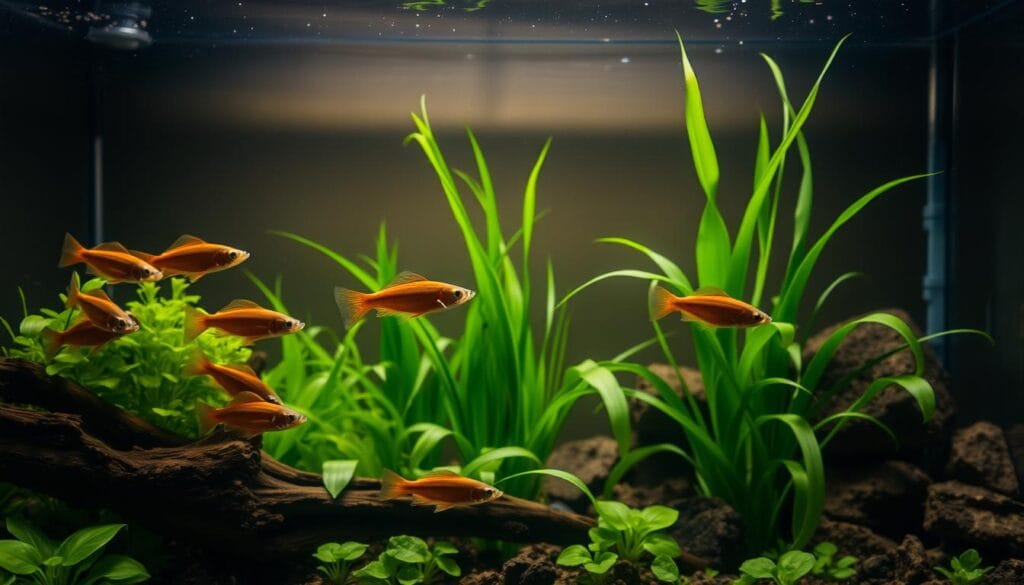
With the right tank, you’re on your way to great otocinclus care. Focus on their needs and create a cozy, healthy space. This way, you’ll get to see your fish grow and thrive.
| Tank Size | Water Temperature | pH Levels |
|---|---|---|
| 10 gallons | 72-82°F | 6.5-7.5 |
Water Parameters and Maintenance Requirements
Keeping the right water conditions is key for your Otocinclus Catfish’s health. Aim for a temperature between 72-82°F and a pH of 6.5-7.5. The water hardness should be 5-10 dGH for their well-being.
For their diet, a mix of algae is essential. But, the water quality affects their digestion. Change the water 10-15% weekly to keep it clean and fresh.
Ideal Water Conditions
- Temperature: 72-82°F
- pH level: 6.5-7.5
- Water hardness: 5-10 dGH
Right water conditions and regular water changes are vital. Use dechlorinated water that matches the tank’s temperature and pH. This prevents stress on your fish.
Essential Diet and Feeding Guidelines
Otocinclus catfish mainly eat algae and plants. In your tank, it’s key to feed them like they do in the wild. Give them algae wafers or pellets for a balanced diet.
You can also add fresh veggies like zucchini or spinach. These veggies are full of vitamins and minerals. Remember, otocinclus catfish love plants.
Natural Algae Sources
Algae on rocks or driftwood is great for them. It’s full of nutrients. You can also add algae supplements for extra nutrition.
Supplementary Foods
Adding spirulina or phytoplankton can boost their diet. These foods are packed with vitamins and minerals.
Feeding Frequency
Feed them 2-3 times a day, just enough for a few minutes. Too much food can harm them. Watch how much they eat and adjust as needed.
| Food Type | Feeding Frequency |
|---|---|
| Algae wafers or pellets | 2-3 times a day |
| Fresh vegetables (zucchini or spinach) | 1-2 times a day |
| Supplementary foods (spirulina or phytoplankton) | 1-2 times a week |
Tank Mates and Community Setup
Choosing the right tank mates for your otocinclus catfish is key to a peaceful aquarium. Otocinclus catfish are peaceful and can live well with other small, calm fish. But, they shouldn’t be with aggressive or fin-nipping fish, as it can stress and hurt them.
To keep your aquarium peaceful, research which fish get along. Pick tank mates that are good for your otocinclus catfish.
Good friends for otocinclus catfish include neon tetras, harlequin rasboras, and dwarf gouramis. These fish are calm and won’t bother your otocinclus catfish. When setting up your aquarium, think about what your otocinclus catfish need. Choose tank mates that fit these needs.
Here are some tips for setting up a community aquarium with otocinclus catfish:
- Research the compatibility of different fish species
- Choose tank mates that are peaceful and non-aggressive
- Consider the otocinclus care requirements and choose tank mates that are compatible with these needs
- Introduce new fish slowly and under close observation to ensure a harmonious community
By following these tips and picking the right tank mates, you can make a beautiful community aquarium. Remember, always take care of your otocinclus catfish and give them a great place to live.
Common Health Issues and Prevention
When caring for your otocinclus catfish, knowing about common health issues is key. These fish are usually tough but can get sick. They might get fungal infections, bacterial infections, or parasites.
Spotting disease signs early is important for otocinclus care. Look out for labored breathing, being very tired, or visible wounds. If you see these, act fast to treat the problem.
Disease Recognition
It’s important to watch for disease signs in otocinclus care. Keep an eye on your otocinclus catfish for appetite, color, or behavior changes.
Preventive Care
Preventing health issues is key for your otocinclus catfish. Regular water changes, a good diet, and a clean tank help a lot. Follow these tips to keep your otocinclus catfish healthy and happy.
Breeding Your Otocinclus Catfish
Breeding otocinclus catfish can be a tough but rewarding task. To help them breed successfully, create a tank that feels like their natural home. This tank should have a temperature of 75-80°F and a pH of 6.5-7.5.
These fish lay eggs and usually breed in the wild during rainy seasons. In your tank, add lots of plants and hiding spots to encourage them to spawn. Also, feed them a diet rich in nutrients to help them breed.
Some important things to remember when breeding otocinclus catfish include:
- Set up a separate breeding tank with the right water conditions.
- Include lots of plants and hiding spots in the tank.
- Feed them a high-quality diet to help them spawn.
- Keep the tank’s temperature between 75-80°F and pH at 6.5-7.5.
By following these tips and taking good care of your otocinclus catfish, you can increase your chances of successful breeding. This will let you enjoy the rewarding experience of raising your own otocinclus catfish.
Always put your fish’s health first. If you have any questions or concerns about caring for or breeding otocinclus catfish, don’t hesitate to ask for advice from experienced breeders or aquarium experts.
| Water Parameter | Ideal Range |
|---|---|
| Temperature | 75-80°F |
| pH Level | 6.5-7.5 |
Troubleshooting Common Care Mistakes
As you keep up with the best otocinclus care for your otocinclus catfish, you might run into some common mistakes. Knowing these issues and how to avoid them is key.
Acclimation Problems
Introducing new fish to the tank can lead to acclimation problems. To avoid this, slowly adjust the fish to the tank’s water. Here’s how to do it:
- Float the unopened bag in the tank for 15-20 minutes to allow the water temperatures to equalize.
- Open the bag and add a small amount of tank water to the bag every 5 minutes.
- Repeat this process for 15-20 minutes to allow the fish to adjust to the tank’s water parameters.
Feeding Issues
Feeding problems can happen if you overfeed or underfeed. To fix this, watch how much they eat and adjust your feeding. Feed them 2-3 times a day, just enough for them to eat in a few minutes.
Environmental Stress Signs
Stress from the environment can occur if the tank’s water isn’t stable. To prevent this, do regular water changes and keep an eye on the tank’s health. Look out for these signs of stress:
- Labored breathing
- Lethargy
- Loss of appetite
| Signs of Environmental Stress | Prevention |
|---|---|
| Labored breathing | Regular water changes |
| Lethargy | Monitor tank conditions |
| Loss of appetite | Adjust feeding habits |
Conclusion
Caring for otocinclus catfish is a rewarding journey. It requires attention to detail and a genuine commitment to their well-being. By understanding their otocinclus care needs, you can create an ideal environment for them.
Remember to closely monitor water parameters, provide a balanced diet, and introduce compatible tank mates. This will help create a harmonious community setup.
With the right approach, your otocinclus catfish will become a captivating addition to your aquarium. They will captivate you with their unique behaviors and play a vital role in maintaining a healthy, algae-free ecosystem.
Embrace the journey of otocinclus care. Watch as these remarkable creatures bring joy and tranquility to your underwater oasis.
FAQ
What is the natural habitat and behavior of Otocinclus?
Otocinclus Catfish come from South America. They live in slow-moving streams and rivers. These small, peaceful fish like to be in schools. They have a unique pattern of spots and stripes.
What is the ideal tank size and setup for Otocinclus?
Otocinclus need a tank of at least 10 gallons. The tank should have lots of hiding spots and plants. This provides them with shelter and food. Also, the tank must have a secure lid because these fish are good jumpers.
What are the ideal water parameters for Otocinclus?
The water for Otocinclus should be between 72-82°F. The pH level should be 6.5-7.5. Water hardness should be 5-10 dGH. Regular water changes of 10-15% every week are needed to keep the water clean.
What should I feed my Otocinclus?
Otocinclus eat algae and plants in the wild. In captivity, they can have high-quality algae wafers or pellets. Add fresh veggies like zucchini or spinach. Feed them 2-3 times a day, only what they can eat in a few minutes.
What are some good tank mates for Otocinclus?
Otocinclus are peaceful and can live with other small, peaceful fish. Good tank mates include neon tetras and harlequin rasboras. But, avoid aggressive or fin-nipping fish to prevent stress and injury.
What are some common health issues in Otocinclus?
Otocinclus can get fungal infections, bacterial infections, and parasites. It’s important to recognize disease signs and treat them quickly. Regular water changes and a balanced diet can help prevent many health problems.
How can I breed Otocinclus in captivity?
Breeding Otocinclus is challenging but rewarding. They are egg-layers and breed in the wild during the rainy season. In captivity, breed them in a separate tank with a temperature of 75-80°F and pH of 6.5-7.5.
What are some common care mistakes to avoid with Otocinclus?
Common mistakes include acclimation problems, feeding issues, and environmental stress. Acclimation problems can be avoided by slowly introducing new fish. Feeding issues can be prevented by monitoring their eating habits. Environmental stress can be avoided by keeping the tank’s water parameters stable.
There are no reviews yet. Be the first one to write one.

